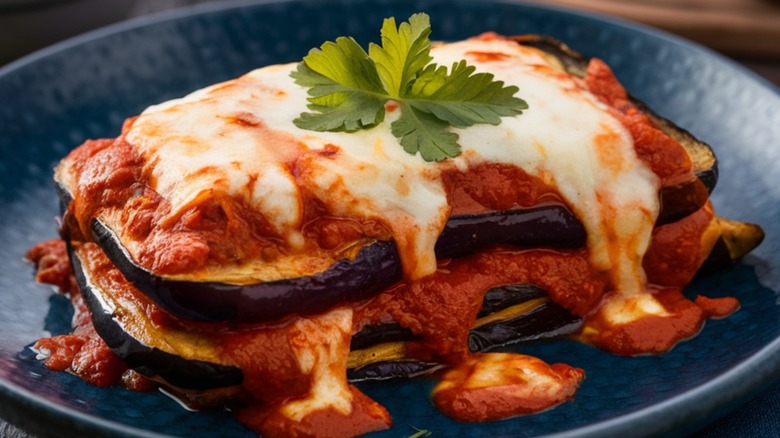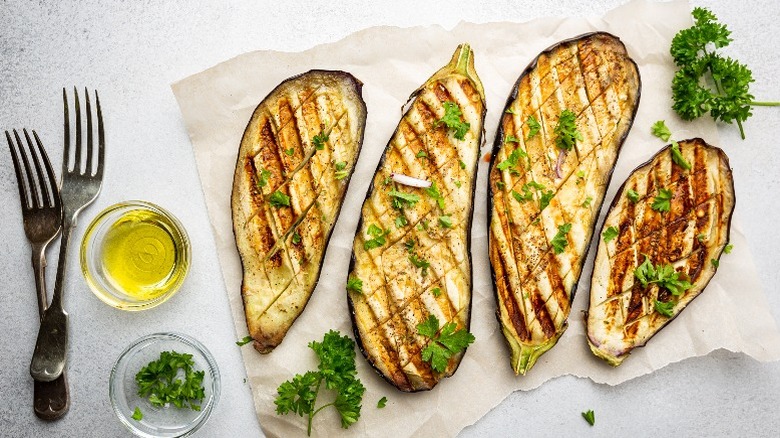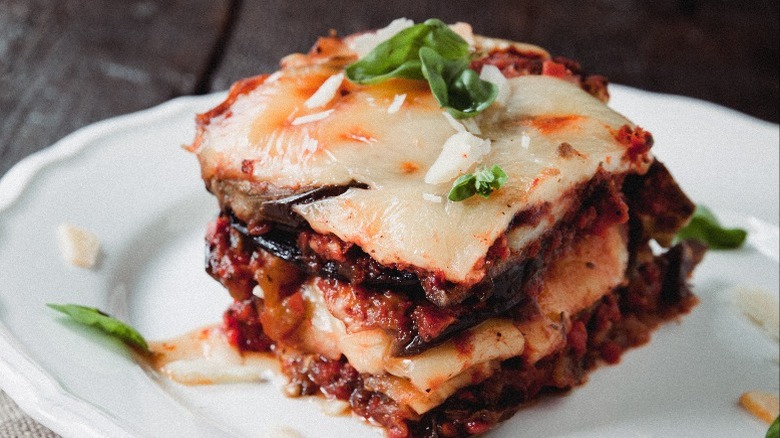The Tastiest Eggplant Parmesan Isn't Fried
Ever since the Arabs brought the eggplant to Italy in the 9th century, it has become a beloved staple of Italian cuisine. Sicilians in particular embraced the vegetable and wasted no time experimenting with it, thus devising dozens of ways to incorporate it into their Mediterranean lifestyle. For instance, think of a rich and comforting pasta alla Norma, or a creamy eggplant risotto.
But there's one dish that undoubtedly outshines the rest — the parmigiana di melanzane, or as the rest of us mere mortals call it, eggplant Parmesan. The dish is made by layering fried breaded eggplant slices in a roasting pan and topping them with marinara sauce, mozzarella cheese, and a generous amount of Parmesan. It's then baked until all the ingredients harmoniously blend together. And if you're feeling extra-brave that day, you can even add creaminess to eggplant Parmesan using a rich vodka sauce.
However, frying the eggplant, even if you use the best type of oil for shallow frying, can sometimes make a meal heavier than you're in the mood for. Luckily, there's a lighter alternative with so much subtle smokiness you may never want to return to the old way of cooking it again: grilled.
How to grill the eggplant
Preparing grilled eggplant Parmesan isn't that different from the classic method. In either case, it's best to dry-brine the eggplant. Surprisingly, as much as 90% of eggplant's weight comes from water. Dry-brining removes that water, improving the eggplant's cooked texture. The outcome won't let you down, as you'll end up with beautifully charred eggplant slices without a trace of sogginess. Just sprinkle some salt onto the slices and let them rest while you make the sauce, about 15 minutes, then rinse them off and dry them before grilling.
It requires a bit more than a dry brine to achieve the original's satisfying crispiness, but you don't have to give up on the crunch just to achieve better flavor. You can get a deliciously crispy result by dipping floured slices in whisked eggs or egg whites before coating them in a mixture of breadcrumbs (regular or panko) and Parmesan. A drizzle of olive oil (or spritz of cooking spray) before tossing them on the grill keeps the breading together. If you need to move it indoors, you can use the oven by coating a baking pan with a thin layer of the best shallow-frying oil you have on hand and cooking the slices in a hot oven on both sides.
Regardless of which cooking technique you choose, the result is a crispy exterior and a soft, juicy (not soggy!) interior. You'll be tempted to devour them before you even get them off the grill. Stay strong, though, because grilled eggplant Parmesan is worth the wait.
Choosing a sauce that preserves the texture
Perfectly grilled eggplant isn't where it all ends. It's important to consider the type of sauce you'll be using. Even though fresh ingredients are trending right now, tomatoes are naturally acidic and while delicious, can hide the beautiful natural flavors you've brought out by grilling. So choosing fresh marinara sauce isn't the best idea if your goal is to preserve the eggplant's smoky flavor.
Using cooked tomato sauce is often a smarter choice. Heat helps enhance the tomatoes' sweetness by concentrating their natural sugars as the water evaporates. And the longer you cook them, the more the acids inside will break down. To further balance the taste, you can always add a touch of sugar or baking soda. There's even a carrot trick to fix acidic tomato sauce. A good-quality store-bought tomato sauce will do the job equally well.
Once that's sorted, a healthy amount of mozzarella and Parmesan and a preheated broiler is all that stands between you and that first heavenly bite. And maybe a basil garnish.


